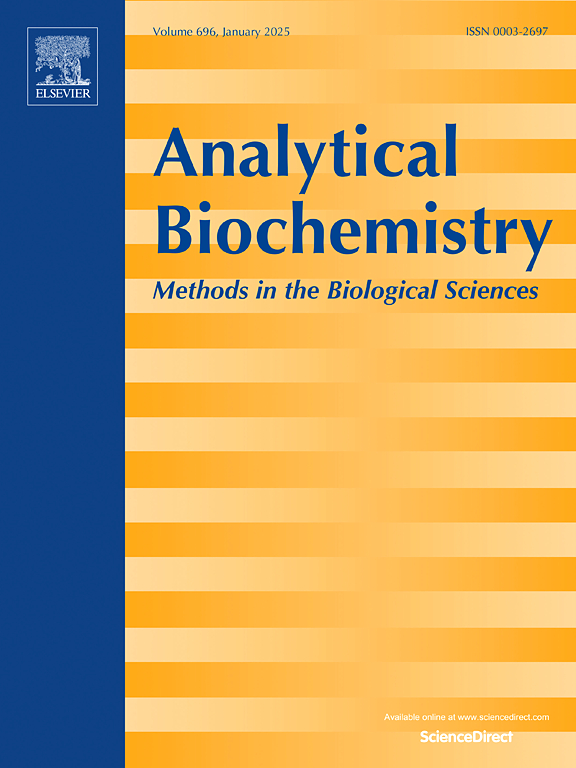用可扩展的“树脂过载”技术分离纯化人类NaPi2b蛋白n端结构域及其功能特性
IF 2.5
4区 生物学
Q2 BIOCHEMICAL RESEARCH METHODS
引用次数: 0
摘要
尽管人们对天然和工程全长膜蛋白的纯化充满热情并取得了进展,但很少有人关注它们的片段,这些片段可以为全长膜蛋白的功能、调控或靶向治疗性抗体(Abs)提供有吸引力的灵感。用于早期发现研究的“治疗性”膜蛋白重组片段的生产需要将其纯化到接近均匀性。它不仅对生物治疗抗体的生产很重要,而且对竞争性蛋白质-抗体、蛋白质-蛋白质和脂质-蛋白质相互作用的结构和功能研究也很重要,这些研究在很大程度上依赖于分离的感兴趣的蛋白质片段的纯度和质量。由于传统的蛋白质纯化方法操作步骤复杂、耗时长、成本高,开发简单而高效的蛋白质纯化新策略一直是生物技术和生物医学领域的研究热点之一。在这里,我们想介绍一种简单而快速的蛋白质纯化策略,用于在实验室规模的细菌宿主中重组表达的人类NaPi2b n端(NT)序列。我们证明了“树脂过载”,例如负载超过动态结合能力的条件,可以反直觉地但智能地用于分离高纯度的蛋白质片段,并防止污染物内源性宿主蛋白的非特异性低亲和力结合。结果表明,这种方法使我们在保持NaPi2b NT序列的免疫原性(被抗体识别)和功能性(磷酸化)特性的同时,获得了最高的纯度。虽然需要根据具体情况进行调整,但我们相信这项工作可以激励其他从事蛋白质和蛋白质片段纯化的研究人员以可扩展的方式应用这一原理证明。本文章由计算机程序翻译,如有差异,请以英文原文为准。

Isolation and functional properties of highly-purified N-terminal domain of human NaPi2b by scalable “resin overload” technique
Despite the enthusiasm and advances in the purification of native and engineered full-length membrane proteins, little attention has been paid to their fragments which could serve as attractive inspiration for function, regulation, or targeting of full-length membrane protein with therapeutic antibodies (Abs). Production of recombinant fragments of “therapeutic” membrane proteins for early-stage discovery research requires their purification to near homogeneity. It is important not only for the production of biotherapeutic antibodies but also for structural and functional studies of competitive protein-Abs, protein-protein, and lipid-protein interactions which heavily rely on the purity and quality of the isolated protein fragment of interest. The development of novel strategies for simple but still highly efficient protein purification remains a one of main research focus in the biotechnology and biomedicine because conventional purification approaches require complex manipulation steps and are timely and costly. Here, we would like to introduce a simple and rapid protein purification strategy for the human NaPi2b N-terminal (NT) sequence recombinantly expressed in a bacterial host at a laboratory scale. We demonstrate that “resin overload” e.g. the conditions when loading exceeds dynamic binding capacity can be counterintuitively but intelligently utilized to isolate highly purified protein fragments and prevent non-specific low-affinity binding of contaminant endogenous host proteins. The results showed that this method allowed us to achieve the highest purity while maintaining both immunogenic (recognition by Abs) and functional (phosphorylation) properties of the NaPi2b NT sequence. Although adaptations are required on a case-to-case basis, we believe this work can inspire other researchers working with the purification of protein and protein fragments to apply this proof-of-principle in a scalable manner.
求助全文
通过发布文献求助,成功后即可免费获取论文全文。
去求助
来源期刊

Analytical biochemistry
生物-分析化学
CiteScore
5.70
自引率
0.00%
发文量
283
审稿时长
44 days
期刊介绍:
The journal''s title Analytical Biochemistry: Methods in the Biological Sciences declares its broad scope: methods for the basic biological sciences that include biochemistry, molecular genetics, cell biology, proteomics, immunology, bioinformatics and wherever the frontiers of research take the field.
The emphasis is on methods from the strictly analytical to the more preparative that would include novel approaches to protein purification as well as improvements in cell and organ culture. The actual techniques are equally inclusive ranging from aptamers to zymology.
The journal has been particularly active in:
-Analytical techniques for biological molecules-
Aptamer selection and utilization-
Biosensors-
Chromatography-
Cloning, sequencing and mutagenesis-
Electrochemical methods-
Electrophoresis-
Enzyme characterization methods-
Immunological approaches-
Mass spectrometry of proteins and nucleic acids-
Metabolomics-
Nano level techniques-
Optical spectroscopy in all its forms.
The journal is reluctant to include most drug and strictly clinical studies as there are more suitable publication platforms for these types of papers.
 求助内容:
求助内容: 应助结果提醒方式:
应助结果提醒方式:


